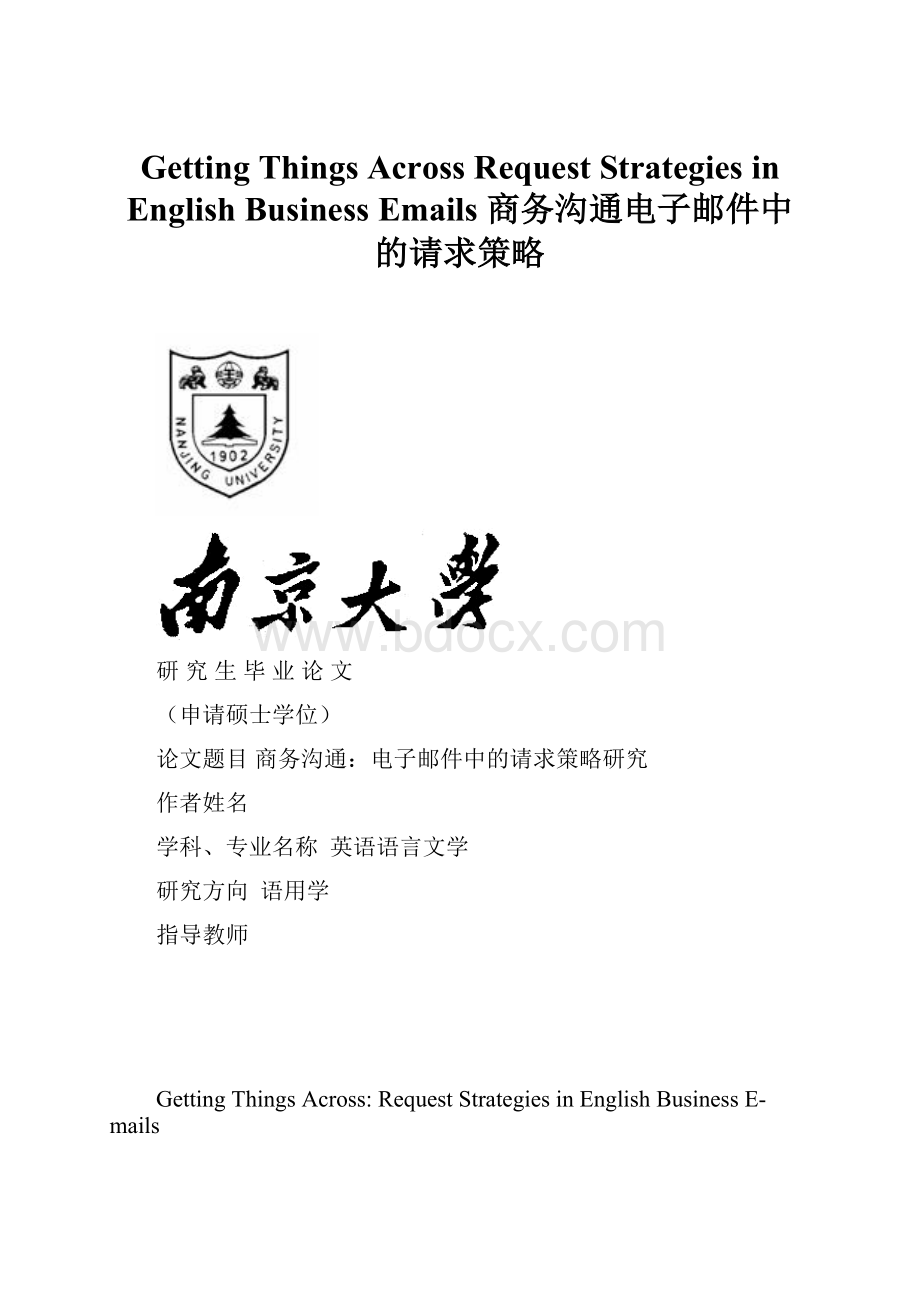 Getting Things Across Request Strategies in English Business Emails商务沟通电子邮件中的请求策略.docx
Getting Things Across Request Strategies in English Business Emails商务沟通电子邮件中的请求策略.docx
- 文档编号:30037097
- 上传时间:2023-08-04
- 格式:DOCX
- 页数:56
- 大小:75.44KB
Getting Things Across Request Strategies in English Business Emails商务沟通电子邮件中的请求策略.docx
《Getting Things Across Request Strategies in English Business Emails商务沟通电子邮件中的请求策略.docx》由会员分享,可在线阅读,更多相关《Getting Things Across Request Strategies in English Business Emails商务沟通电子邮件中的请求策略.docx(56页珍藏版)》请在冰豆网上搜索。

GettingThingsAcrossRequestStrategiesinEnglishBusinessEmails商务沟通电子邮件中的请求策略
研究生毕业论文
(申请硕士学位)
论文题目商务沟通:
电子邮件中的请求策略研究
作者姓名
学科、专业名称英语语言文学
研究方向语用学
指导教师
GettingThingsAcross:
RequestStrategiesinEnglishBusinessE-mails
UndertheSupervisionof
ProfessorChenXinren
SubmittedinPartialFulfillmentoftheRequirements
FortheDegreeofMasterofArts
EnglishDepartment
SchoolofForeignStudies
NanjingUniversity
Iherebydeclarethatthissubmissionismyownworkandthat,tothebestofmyknowledgeandbelief,itcontainsnomaterialpreviouslypublishedorwrittenbyanotherpersonormaterialwhichhastoasubstantialextentbeenacceptedfortheawardofanyotherdegreeordiplomaatanyuniversityorotherinstituteofhigherlearning,exceptwheredueacknowledgmenthasbeenmadeinthetext.
Signature:
Name:
Date:
ACKNOWLEDGEMENTS
I’mdeeplyindebtedtomanypeoplefortheirhelp.Withouttheirprecioushelp,thisthesiswouldnothavebeenfinished.
FirstandforemostIwouldliketothankmysupervisor,Prof.ChenXinren.Fromtheverybeginningofthisthesis,hehasprovidedmewithgreatinspirationandvaluableguidanceinthethesiswritingclassgivenbyhim.Inmyprocessofwritingthisthesis,hehascarefullyreadandrereadthedraftandofferedmanywell-informedcomments.Withouthisvaluablesuggestions,unfailingencouragementandgreatpatience,thecompletionofthepresentpaperwouldhavebeenimpossible.
I’mgratefultomyacademicbrother,LiMing,whohelpedmealotwiththedataanalysisonthequestionnaire.ThanksalsogotoAssociateProf.WangWenyu,thelecturerofresearchmethodsandthesiswriting,whoseclassbenefitedmealotinthemethodologypartofthisthesis.
Manythanksshouldgotomyclassmatesinthethesiswritingclasswhocameupwithmanyhelpfulideasformythesis.I’malsogratefultomyclosefriends,CaoLiang,CongCong,YangHui,etc.,whogavememanysuggestionsonhowtodealwiththequestionnaire.
Ishouldalsoexpressmyappreciationtotheparticipantsofthestudy,someofwhomareformerclassmatesofmine.Withouttheirhelp,thereisnowaythatIcouldobtainnaturallyoccurringcontextsasthemaindataofmythesis.
S.S.M
ABSTRACT
Inthefieldofspeechactstudies,mostofthepreviousresearchrelatedtopolitenessfocusedondailycommunication.However,asthestudiesonspeechactsaredevelopingfasterandbroader,linguistshavebeenpayingmoreandmoreattentiontospecificfieldsofcommunication,forinstance,technicalwrittencommunicationandbusinesscommunication,toexplorethefeaturesofspeechactsindifferentregisters.
Thepresentstudyattemptstoconductaquantitativestudyonrequestsandrequeststrategiesinbusinesswrittencommunicationconcerningthedegreeofpolitenessanddirectness.InspiredbytheexitingstudiesonEnglishrequeststrategies,especiallyTrosborg’scategorization,thepresentauthordevelopsanewcategorizationframeworkofrequeststrategies.ComparisonbetweentherequestsmadebyChineseandthosebynativespeakersofEnglishismadetofindouttheirdifferencesandtendencies.Tofigureoutthecorrelationbetweentheworkingexperienceandthepragmaticcompetence,comparisonbetweentherequestsmadebynovicesandthosebyveteransisalsoconducted.
Differentfrompreviousresearch,thisstudycollectedfirst-hande-mails.Intotal189businesse-mailswerecollectedasthesourceofnaturallyoccurringcontextsfromtwelvebusinessmenhomeandabroad.AquestionnairewasalsodesignedtoinvestigateChinesebusinessmen’sopiniononthedegreeofpolitenessforeachrequeststrategy.Itwasdistributedto39businessmenfromdifferentinternationaltradecompaniesinChina.
Thedataanalysisinthisstudygeneratedthefollowingfindings.First,expressingrequestsexplicitlyisthemostfrequentlyusedstrategyinbusinesswrittencommunication,whichtellsthedifferencebetweenbusinesscommunicationanddailycommunication.Second,withnosignificantdifferencesinthedegreeofpoliteness,ChineseandnativeEnglish-speakingbusinessmensharethesamefavoriterequeststrategy(i.e.expressingrequestsexplicitly).Lastbutnotleast,thepragmaticcompetenceofveteransishigherthanthatofnovices,whichsuggestsimprovementcanbemadetonovices.
Thepresentstudyhasimplicationsinmanyways.Tobeginwith,themodifiedcategorizationofrequeststrategiestogetherwiththesuggesteddegreesofpoliteness(DOP)foreachstrategymakescontributionstospeechactstudies.Besides,thisstudycontributestocross-culturalcommunicationaswellasEnglishforBusinessandEconomics(EBE)teachingandlearning.Thepresentstudysuggeststhatspecificregistersbeanimportantthemeforcross-culturalcommunicationresearch.Thedifferencesbetweenthedatafrome-mailsandthedatafromthequestionnairesimplythatinordertohavecredibleresultsitisnecessarytoobtaindatafromnaturallyoccurringcontexts.ForthefieldofEBE,itissuggestedthatmoreeffortsshouldbemadetostudyspeechactsinthisfield,whilefurtherimprovementsshouldbemadetoimprovethepragmaticcompetenceofChineseEnglishlearners.
Keywords:
requeststrategy,businessletters,politeness,pragmaticcompetence
摘要
沟通对于任何经济活动来说都十分重要,对于跨文化商务活动来说更是如此。
而成功的跨文化商务沟通不仅要求良好的语言(语法)能力,同时也需要相应的语用能力。
请求是跨文化商务沟通当中最为常见的言语行为之一,能否用合适的语言进行表达对请求的效果起着不可忽视的作用。
言语行为理论的相关研究一直以来都以日常交际为主题。
然而随着该方面研究的不断深入和延伸,人们已经开始越来越关注专门领域的交际和沟通,例如科技写作、商务沟通等,以便探索言语行为在不同语域的特征。
本文从礼貌和直接程度角度对请求和请求策略进行定量分析。
基于前人对英语请求策略的研究,特别是Trosborg的分类,本文提出了新的请求策略分类框架,同时对其中各个策略类别进行定义,用例句加以说明,并对其礼貌程度进行分析。
本文着重比较了中国商务人员和英语本族语者在商务信函中使用请求策略的特点和趋势,以及中国商务人员中老手和新手在商务信函中使用请求策略的不同情况和趋势。
与以往研究不同的是,本文收集了来自于十二家国内外不同外贸公司的一百八十九封电子信函,作为第一手语料,保证了其真实性和完整性。
同时,作者设计了一份有关中国商务人员对请求策略礼貌程度的认识的问卷调查。
三十九位来自不同外贸公司的中国商务人员认真填写了该问卷。
本文数据分析的结果如下:
首先,在商务信函中最为常用的请求策略是直接提出请求,表明商务英语和日常对话中言语行为的区别。
其次,中国和英语本族语商务人员最常用的策略是一致的(即直接提出请求),同时两者使用请求的礼貌程度相近,没有显著区别。
此外,更重要的是,语料数据结果显示商务人员中老手的语用能力要高于新手,表明新手在此方面有待提高。
通过对真实例句的分析,我们可以看出请求策略作为商务沟通语用手段的一种可以有效地促进请求内容的达成,推动贸易双方进一步的交流。
首先,本文中对请求策略的分类以及对各个策略礼貌程度的评分(DOP)对言语行为的研究作出了一定的贡献。
同时,本文对跨文化交际和商务英语等方面都有一定的指导意义。
跨文化交际研究应该考虑到具体的语境。
针对跨文化交际中的言语行为研究,本文中电子信函和调查问卷所得出的结果之间的差异表明为了得到更加真实全面的结论有必要获取真实自然的语料。
此外,商务英语作为一种特定体裁,对其中言语行为的研究有助于我们更加全面的了解其特点。
同时,商务英语教学中应该注重提高中国英语学习者的语用能力。
关键词:
请求策略商务信函礼貌语用能力
TABLEOFCONTENTS
ACKNOWLEDGEMENTSi
ABSTRACTii
摘要iv
LISTOFTABLESviii
LISTOFABBREVIATIONSix
ChapterOneINTRODUCTION1
1.1ObjectoftheStudy1
1.2NeedfortheStudy2
1.3SignificanceoftheStudy3
1.4OutlineoftheThesis3
ChapterTwoLITERETUREREVIEW5
2.1DefiningRequests5
2.1.1Previousdefinitionsofrequests5
2.1.2Requestsinthepresentstudy6
2.2ExistingStudiesonRequestandRequestStrategies6
2.2.1Requestincross-culturalspeechactstudies6
2.2.2Existingcategorizationofrequeststrategies7
2.3ExistingStudiesonBusinessE-mails9
2.3.1Definitionofbusinesse-mail9
2.3.2RelatedstudiesonEBE9
2.3.3RelatedstudiesinChina10
2.4Summary11
ChapterThreeTHEORETICALFRAMEWORK12
3.1TheoreticalBasisforthePresentStudy12
3.1.1SpeechActTheory12
3.1.2FTAandstrategiesfordoingFTAs13
3.2CategorizationFrameworkforthePresentStudy14
ChapterFourMETHODOLOGY19
4.1ResearchQuestions19
4.2Participants20
4.3DataCollection21
4.3.1Collectingbusinesse-mail21
4.3.2Politeness-of-requestquestionnaire22
4.4DataAnalysis23
4.4.1Analysisofthee-maildata23
4.4.2Analysisofthequestionnairedata27
ChapterFiveRESULTSANDDISCUSSION28
5.1RequestStrategiesCommonlyUsedbyBusinessmeninE-mails28
5.2ComparisonofRequestStrategiesUsedbyChineseandNativeEnglish-SpeakingBusinessmen30
5.3ComparisonofRequestStrategiesUsedbyNovicesandVeterans32
5.4ChineseBusinessmen’sPerceptiononRequestDOP34
ChapterSixCONCLUSION38
6.1MajorFindings38
6.2ImplicationsoftheStudy39
6.2.1Implicationsforspeechactstudies39
6.2.2ImplicationsforEBEteachingandlearning39
6.3LimitationsoftheStudyandSuggestionsforFutureResearch40
REFERENCES42
APPENDIX:
POLITENESS-OF-REQUESTQUESTIONNAIRE45
LISTOFTABLES
Table2.1:
Trosborg’sCategorizationofRequestStrategies8
Table3.1:
CategorizationofRequestStrategies14
Table4.1:
BasicInformationaboutEachParticipant20
Table4.2:
TheNumberofE-mailsfromEachPairofParticipants21
Table4.3:
StructureofthePoliteness-of-RequestQuestionnaire22
Table4.4:
TheModifiedCategorizationofRequestStrategies25
Table4.5:
TheValueofAlphaforEachIteminPartC27
Table5.1:
FrequencyofRequestStrategiesBeingUsed29
Table5.2:
ComparisonAmongEachStrategyUsedbyChineseandNatives30
Table5.3:
ComparisonBetweenChineseandNativeBusinessmen(standardized)31
Table5.4:
APDOPofEachParticipant32
Table5.5:
T-testsReportfortheDifferencebetweenChineseandNatives32
Table5.6:
ComparisonAmongEachStrategyUsedbyNovicesandVeterans33
Table5.7:
ComparisonBetweenNovicesandVeterans(standardized)34
Table5.8:
T-testsReportfortheDifferencebetweenNovicesandVeterans34
Table5.9:
DOPofRequestStrategiesinChineseBusinessmen’sMind35
Table5.10:
ChineseBusinessmen’sBeliefaboutMakingRequests36
Table5.11:
ChineseBusinessmen’sBeliefsaboutReplyingRequests36
Table5.12:
ChineseBusinessmen’sAttitudesConcerningDifferentFavors36
Table5.13:
FrequencyofRequestStrategiesintheQuestionnaire37
LISTOFABBREVIATIONS
1.APDOPaveragepointofdegreeofpoliteness
2.Cat.category
3.CCSARPCross-culturalSpeechActRealizationProject
4.DOPdegreeo
- 配套讲稿:
如PPT文件的首页显示word图标,表示该PPT已包含配套word讲稿。双击word图标可打开word文档。
- 特殊限制:
部分文档作品中含有的国旗、国徽等图片,仅作为作品整体效果示例展示,禁止商用。设计者仅对作品中独创性部分享有著作权。
- 关 键 词:
- Getting Things Across Request Strategies in English Business Emails 商务沟通电子邮件中的请求策略 商
 冰豆网所有资源均是用户自行上传分享,仅供网友学习交流,未经上传用户书面授权,请勿作他用。
冰豆网所有资源均是用户自行上传分享,仅供网友学习交流,未经上传用户书面授权,请勿作他用。
链接地址:https://www.bdocx.com/doc/30037097.html


 《贝的故事》教案4.docx
《贝的故事》教案4.docx
